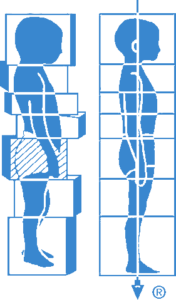

What is Rolfing®?
Rolfing® Structural Integration, also known as Myofascial Structural Integration, was developed by Dr. Ida P. Rolf, Ph.D. (1896-1979). It is a form of manual soft tissue manipulation and movement education based on aligning segments of the body (head, torso, pelvis, legs) with each other in the larger field of gravity.
This results in greatly increased freedom of movement, better balance, improved physiology, and enhanced proprioception and coordination. As this process continues over time, children move through life with more grace and intelligence.
As the body becomes more grounded in physical reality, this manifests as more self-confidence and security both emotionally and mentally.
The energy that was contained in patterns of mis-alignment is freed through Rolfing® and a more creative use of that energy emerges.
Why Rolf Children?
There is a prevalent notion that babies and children are “perfect” and that we somehow “go wrong” in adulthood and end up with all the chronic complaints and common mis-alignments we see all around us. On closer examination, we can watch as babies and children move and see the same random patterns of adults, although they are usually less fixed.
Often the structural issues of parents and older siblings become imprinted on the developing brains and bodies of babies and young children as the best or correct way to move. Examples of this include:
Other examples are odd or uncoordinated patterns of movement in running and walking, often with excessive tripping and falling. These sub-optimal patterns do not go away on their own, but become the way the body organizes itself in space and persist through time.
Since this is the time that children are forming their patterns and habits, we can take advantage of their inherent plasticity (both soft-tissue and brain) and mold them into a more balanced and appropriate structure. This integrated and coherent pattern will replace the random one and persist through life, preventing many of the common adult problems.
More importantly, perhaps, is what occurs in the present as babies and children receive this work. By enhancing the developmental and maturation process that is already taking place, children immediately enjoy the effects of structural integration including better balance and proprioception, increased coordination, and harmonious functioning of body systems (such as digestion, elimination, etc.)
As height and weight normalize, small underweight children blossom as they are no longer targeted or ridiculed by their peers. Bigger children move with the grace and ease of royalty. Formerly uncoordinated kids are no longer the last to be chosen for a team. For parents who are interested in having a future athlete or dancer in their home, Rolfing® is invaluable.
Since all behavior is expressed through the musculo-skeletal system, as movement changes, behavior changes. The child is aware that s/he feels “better”. The behavioral changes are often more apparent to the adults in the child’s life, manifesting as a happier, healthier, more relaxed and cooperative person to live with.
Is Rolfing® Only for Children with Disabilities?
Not at all. Any baby or child can benefit from this work. It can help with a wide range of issues that most babies and children experience such as:
For children with scoliosis Rolfing® can be utilized very effectively during the “wait and see” period when there are no medical interventions suggested. It is also useful in addition to suggested treatments and may help avoid surgery. Rolfing® can be very beneficial for mild to moderate scoliosis and may be able to stabilize more advanced curvatures depending on the age and structure of the child as well as the degree of curvature.
For children with disabilities Rolfing® will give them the best possible use of their body. Spasticity (as in Cerebral Palsy) can be reduced, leading to smoother more efficient movement (see Stanford University School of Medicine Research Project on this website). Weak or low toned muscles are strengthened as the entire body is integrated and brought into better balance. Gross and fine motor coordination improve as does attention and concentration. With babies, developmental delays can often be lessened and the process of growth accelerates.
For gifted children this work is an essential component, providing much needed grounding and knowledge of their body. It can lessen the deleterious effects of aspects of giftedness such as hyper-sensitivity and emotional intensity. By enhancing psychomotor development, Rolfing® helps the children channel their heightened emotional and creative energies and advanced intellectual abilities more appropriately. They are empowered by taking responsibility for their own body, and realizing the benefits of self-care at a young age. This will last them a lifetime.
How is Rolfing® Babies and Children Different than Rolfing® Adults?
The sessions are more playful. The timing and pacing is geared to the child’s age and maturity, as well as their mood at the time of the session. The work is often done on the floor while playing with the many toys in my studio. The sessions may also be done with the baby or child in the safety of the parent’s lap. The child may be lying on the table (with or without the parent lying next to them) as the parent reads to them or they play or just relax quietly.
Breaks are taken as often as needed. This is a time for them to self-integrate the changes that have been induced by the work. They do this through movement, play, interacting with others, exploring the environment, and other forms of expression.
The child is empowered to be an active participant in the session. Their wishes and desires are acknowledged and acceded to. They are asked directly (verbally and nonverbally) about their own body and are encouraged to express how they feel, bodily and emotionally.
Are There any Contraindications?
Acute and inflammatory conditions are contraindicated as are certain rare medical conditions such as osteoporosis (rare in children) or other diseases. Rolfing® is about establishing better structural balance and patterns of health, not treating disease. Babies under 18 months need to be evaluated by their pediatrician prior to the first Rolfing® session to rule out any medical issues that could pose a problem.
At What Age Can a Baby or Child Receive Rolfing®?
At any age. I have worked with newborns 36 hours old.
How Many Sessions are Needed?
That depends on the age and the issues. I recommend at least one “well-baby check-up” in the first two to six months of life. If all is well, perhaps one or two follow-up visits a year as they begin to walk, get out of diapers,etc.
For children under seven, if/when issues arise, they can usually be handled in one or two sessions if there are no disabilities or developmental delays. Reasons to bring your child in for a session include:
I generally recommend starting the basic ten series of Rolfing® sessions any time after age seven or eight as younger children usually do not need that concentrated of an intervention. Pre-teen and teen years are an excellent time to receive Rolfing® as children adjust to the changes and challenges of adolescence. The sessions are usually done once a week or every two weeks, taking about three to five months to complete.
After the basic series is completed, further work is indicated by the needs and circumstances of the child’s growth and life. Rolfing® is particularly useful at transition points such as starting and finishing middle school and high school. It is also very helpful with any major life change that impacts a child such as divorce or a death in the family.
For children with disabilities, developmental delays, or special needs, the younger they start the work the better. The timing and frequency of sessions will vary according to the individual.
How Long is a Session?
Usually 50-70 minutes. This allows the child time and space to explore, get settled and ready for the work, as well as not hurrying out afterwards.
What Can I Tell My Physician/Health Care Provider about Rolfing® for Babies and Children?
You may print the following to give to her/him:

Rolfing® Structural Integration, also known as Myofascial Structural Integration, is a system of manual manipulation and movement education developed by Dr. Ida P. Rolf, Ph.D. (1896-1979).
It is beneficial for most chronic childhood problems and is complementary with most recommended medical treatments. Rolfing® is also very effective where conventional interventions such as drugs or surgery are not indicated or are not proving effective.
These include and are not limited to: